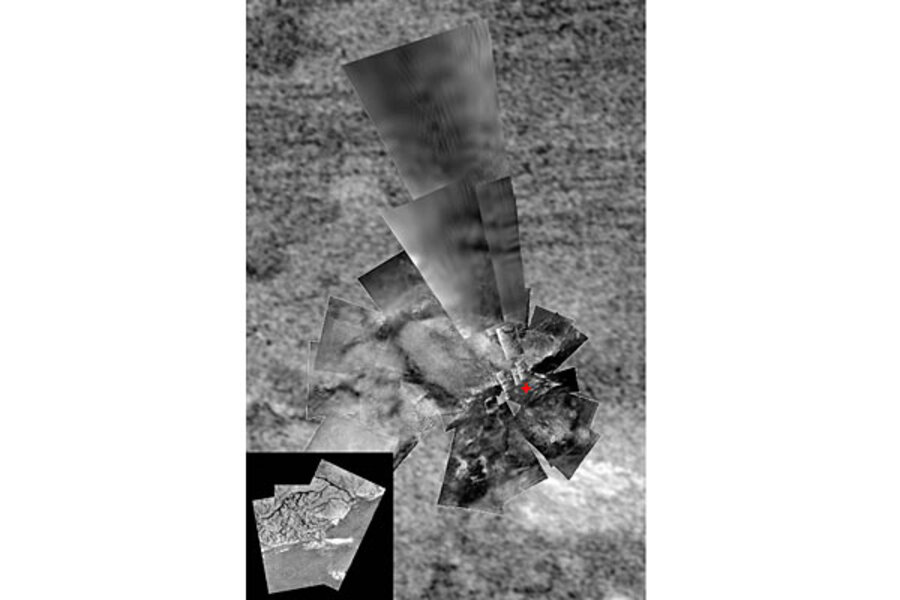Tropical lake on Titan? Surprising find could solve moon's methane mystery.
Scientists have spotted a Great Salt Lake-scale patch of liquid methane on the surface of Saturn's moon Titan, along with smaller swamp-like features, in an unexpected and intriguing place.
Data from the Cassini spacecraft currently touring the Saturn system have already revealed lakes at Titan's poles, fed by summertime methane rain. But Cassini's radar found nothing similar at lower latitudes, and climate models have suggested that long-lived lakes might be impossible there.
Now, the discovery of the large, shallow lake in the moon's tropics may offer scientists clues about the processes driving a moon that has fascinating similarities to Earth before life emerged.
If the finding is confirmed by additional observations, it could imply the existence of significant subsurface methane deposits feeding the tropical lake. Or perhaps the moon recycles methane, with the liquid in polar lakes migrating underground back to the tropics, where it wells up again in lakes.
Whatever the cause, the discovery could have important implications for understanding how Titan maintains a methane cycle that is strikingly similar to the water cycle on Earth – with methane evaporating as gas, falling as rain, and gathering in lakes.
The report in Thursday's issue of the journal Nature represents a "significant discovery," says Tapio Schneider, a scientist at the California Institute of Technology who models planetary climates, including the moon Titan's.
On Earth, vast oceans are the source for the water cycle. On Titan, however, the known surface deposits of liquid methane are far too sparse to fully support the moon's methane cycle. That's because methane in the atmosphere readily breaks down into its components, carbon and hydrogen, when exposed to sunlight. Over the moon's 4.5 billion-year-old history, that process would have consumed all the known quantities of methane.
Something, it seemed, needed to be replenishing the moon's supply of surface methane. The lake in Titan's tropics, which appears to be a long-lived feature, may help identify one of the sources needed to sustain the cycle, researchers say.
The lake's location is key. The phrase "Titan's tropics" might seem like an oxymoron, considering that the moon's surface temperature averages minus 290 degrees Fahrenheit. Nevertheless, the moon's equatorial regions receive the most consistent sunlight throughout the course of its "year."
Previous climate studies "indicated convincingly that any liquid on Titan's tropical surface would quickly evaporate and be quickly transported to the pole," says Caitlin Griffith, a planetary scientist at the University of Arizona who led the team reporting the results.
Discovering the tropical lake "was completely unexpected," Dr. Griffith says.
Cassini's travel mate, the European Space Agency's Huygens lander, seemed to reinforce that when it parachuted to the surface in 2005. Upon touchdown at a landing site within the equatorial belt, its sensors detected a brief puff of methane rising from a surface covered with sand-like ice grains. This suggested that it landed on a surface slightly dampened with the liquefied gas – but certainly no hydrocarbon lake or ocean, as some had expected.
Indeed, as Cassini continued its flybys of Titan, its radar found no lakes in the tropics, though it did find deep, vast lakes in polar regions. Yet now at least one lake appears to be present. How could Cassini have missed something the size of the Great Salt Lake in Utah?
At the radar's operating frequency, a body of liquid methane would have to be at least 26 feet (eight meters) deep in order to absorb all of the radio waves, giving it a pitch-black appearance on radar images. At shorter, near-infrared wavelengths, the liquid can be far shallower and still show up as black in the images. Those images revealed a black patch covering some 930 square miles (2,400 square kilometers) of Titan's tropical surface.
The team estimates the lake's depth to be at least three feet (one meter). In addition, it detected other, smaller patches of liquid methane from ankle to knee deep.
So far, the team has analyzed only about 17 percent of the moon's tropics, so it's unclear if this lake and "wetlands" in the region represent more widespread surface features – in essence, oases spread throughout an otherwise arid belt encircling the moon, Griffith says.
Still, the find raises intriguing possibilities for understanding the moon's methane cycle. The lake and wetlands have been there since 2004, before Cassini scientists observed clouds and possible rainstorms in the tropics, notes CalTech's Dr. Schneider. That suggests "a subsurface source of methane," he writes in an e-mail exchange.
Modeling results he and colleagues published in January in Nature suggest methane at low and high latitudes could be linked either through as-yet undetected rivers on the surface or below the surface.
Or the tropics could harbor large subsurface deposits locally.
Griffith points out that Titan's orbit is nearly circular, but at one time would have been more elliptical that it is today. As Titan's orbit changed, the moon would have been stressed by Saturn's gravitational forces. This tugging and hauling would have generated heat in Titan's interior, perhaps melting methane ices and allowing them to migrate toward the surface.
Much of the scientific interest in Titan stems from the abundance of hydrocarbons such as methane in its atmosphere and on its surface, with abundances thought to be similar to those of the early Earth.






